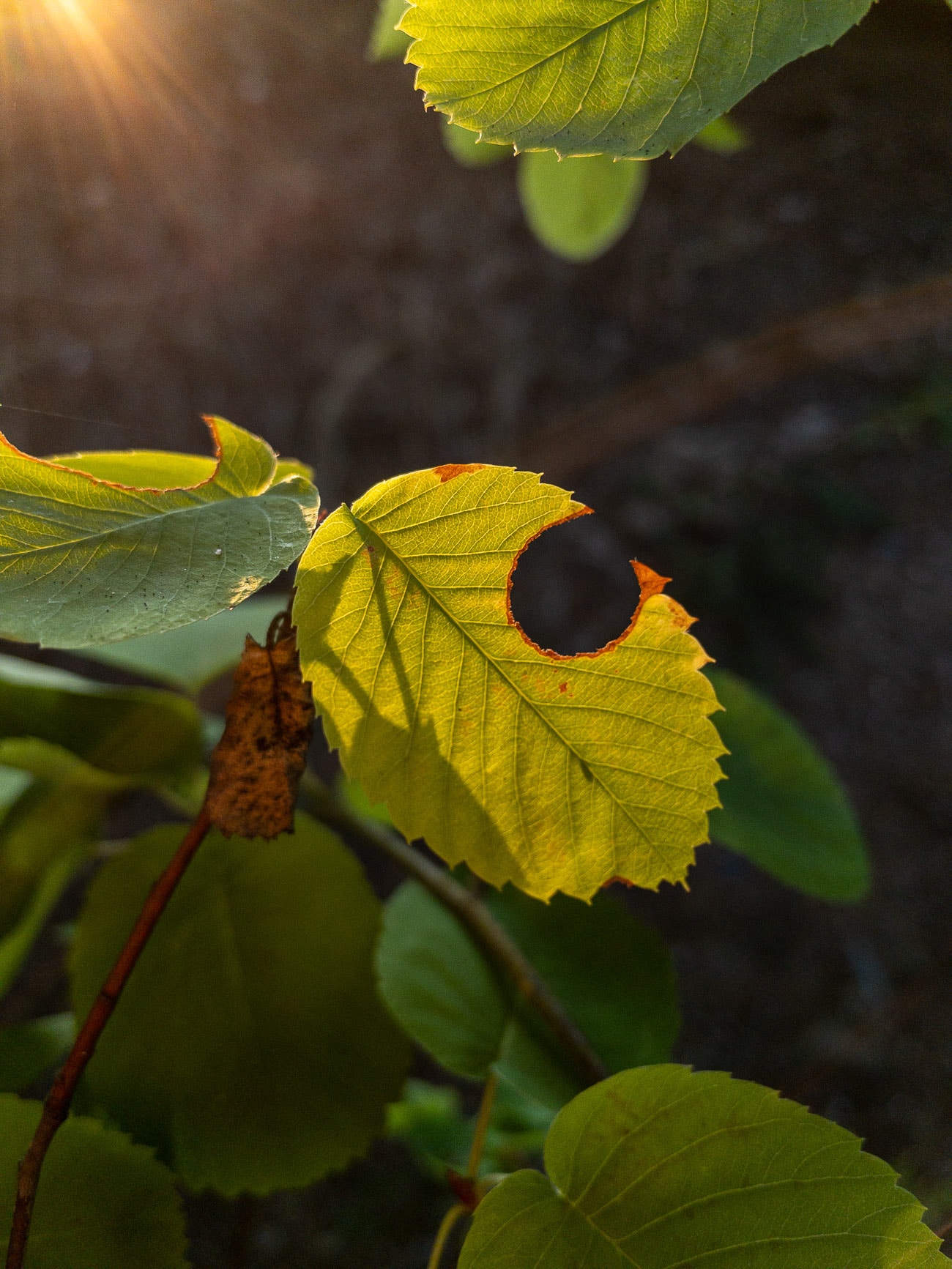
During a dry stretch last summer I was reluctantly spraying water from a hose. I know the spot but I can’t remember the plants. The urge to water the ground seems to follow basic logic: we get thirsty, we need water, doesn’t everything? But it ignores a fundamental problem with yards: there are plants that are adapted to our summers, we just don’t plant enough of them.
Back to that moment. While watering, I saw a large-looking bee settle on a leaf just out of range. The bee looked almost as big as a bumblebee but I could tell that it wasn’t. I’ve seen bumblebees crawl on the ground or sleep on a leaf, but this one seemed to be waiting for something. I stopped the flow of water to take a close look and I grabbed my phone to record. Then it took flight, a bit wobbly but with a mission.
Zig-zagging toward me, it homed in on a dead leaf and steadied itself before landing. Once on the ground I could see that it was a leaf-cutter bee—its flight was chaotic because of the weight of the leaf that it was carrying, rolled up in its legs. It had looked confused to me, but it found the right spot. Suddenly it disappeared into the ground, and was gone for two minutes.
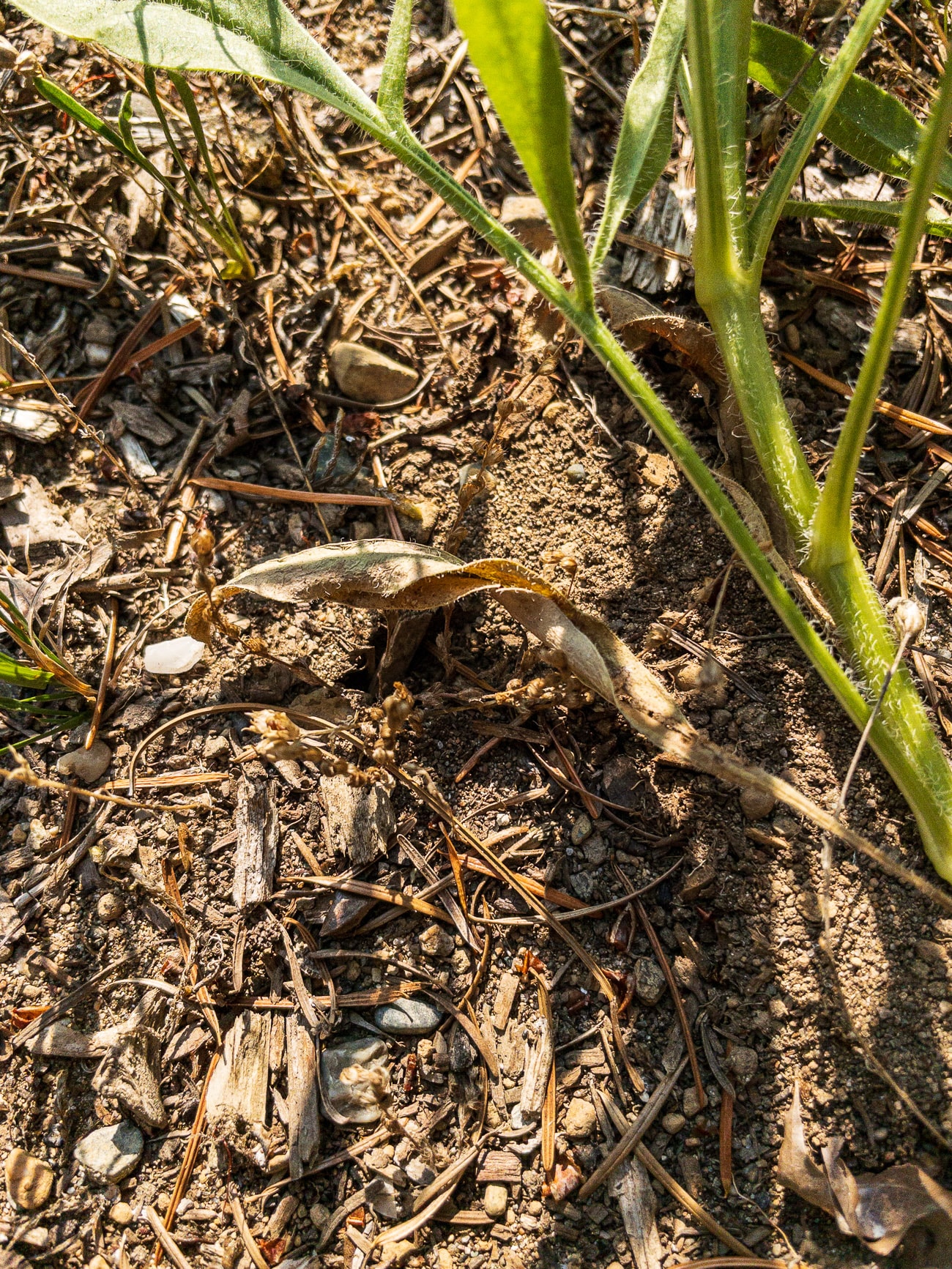
This was not the first time I saw a leaf-cutter bee in the yard—that happened a month before—but it was the first time I had proof that they were nesting here. Though some leaf-cutter bees will use holes above ground, this one was using with my sandy, quick-draining soil, to tunnel underground and make a leaf-lined nest. If the larva survived, the new leaf-cutter bees will emerge this summer.
It was exciting to see this for a number of reasons. First off, it’s just cool to watch a bee carry a leaf and find a hole that it has memorized. And then see it repeat this process. It took about five minutes between trips and I watched it come and go a few times. Honestly, I would’ve like to stay there all day.
Emotional reaction aside, this was direct proof of why bare ground is useful in your yard. If you provide food for pollinators— something that every book, nursery, seed packet, and grower urges you to do—then you should also provide suitable places for them to live. An old Benjamin Franklin proverb states that “a man fed without a bed is a man left for dead,” and that rings true even though I just made it up. Seriously, as much as you can, keep piles of debris, leaves, wood, and exposed dirt. There are ways to clean up your yard and not really clean it up.
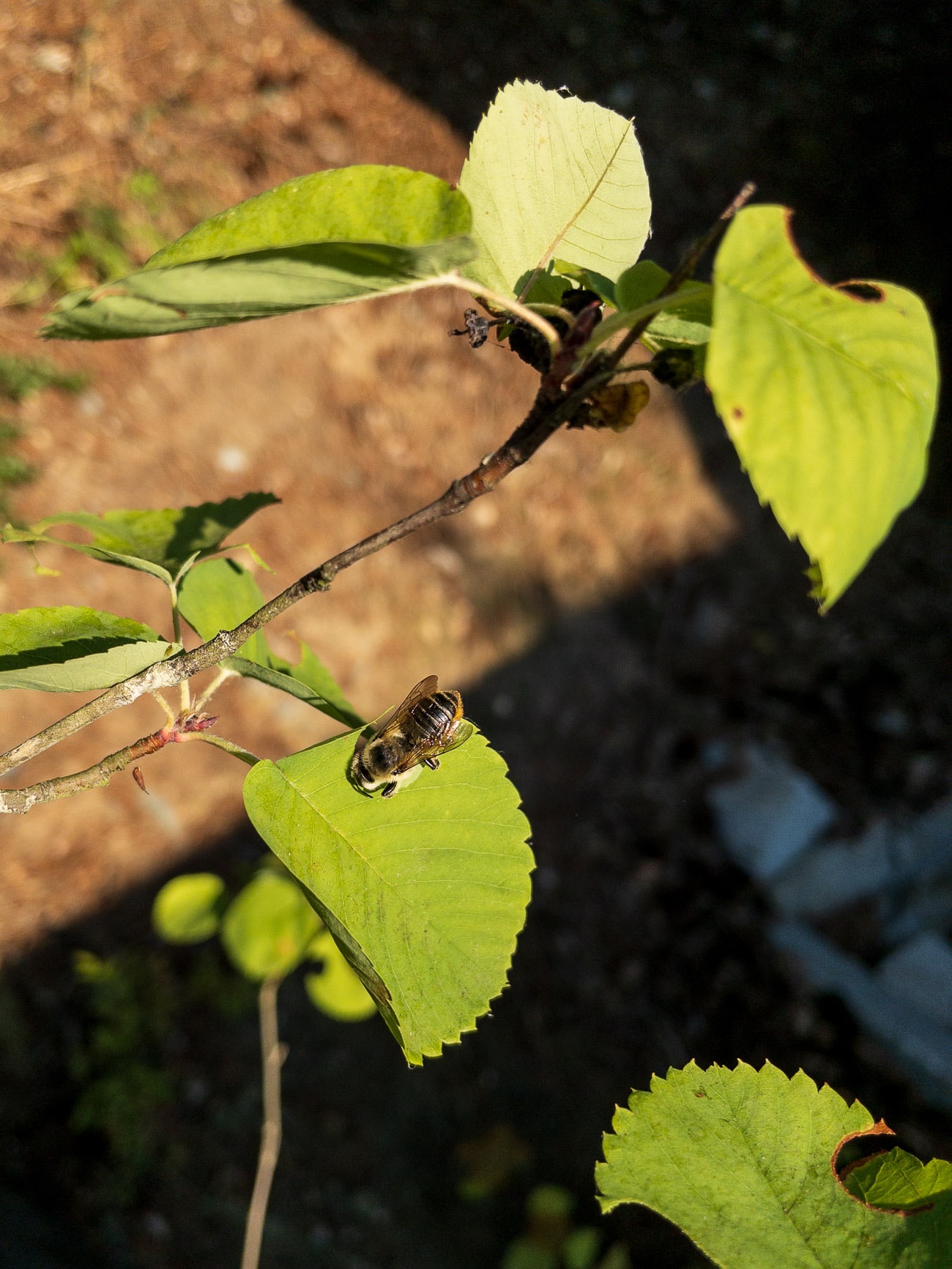
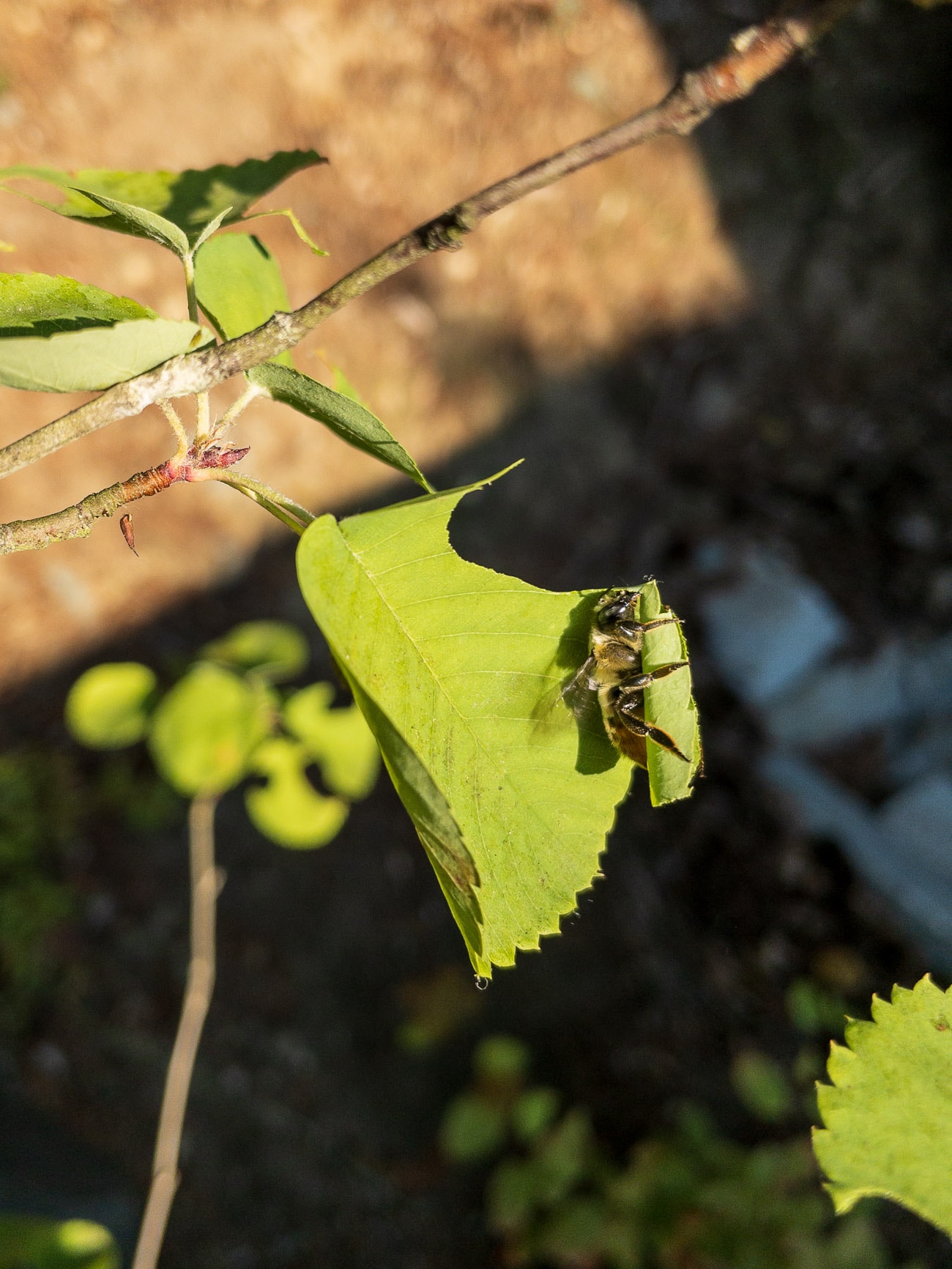
Honey bias
Honeybees don’t know how good they’ve got it. They’re facing colony collapse disorder, but maybe that’s the price they have to pay for hijacking everyone’s understanding of what a bee is. If you ask someone to describe a bee, I bet they’d say it’s yellow and black and has a hive full of hexagons, it makes honey and stings people.
I’ll defend it on the stinging part—most bees are too busy to bother with stinging you. Many bees can’t even sting you if they tried. If you got stung as a kid, I bet it was a wasp.
So what’s wrong with describing bees, like I did above? The main thing is that almost all bees are solitary, they are not social and do not make hives. They tunnel in a hole found in wood, a dead plant, the side of a hill, and lay eggs all by themselves. There are some 4,000 bee species in North American and 20,000 in the world, and well over 90% are like this. They are independent and often not yellow at all. Lastly, honeybees are all native to Eurasia—they were brought to North America. Everyone who likes bees or has a farm should spend time encouraging wild, native bees to thrive.
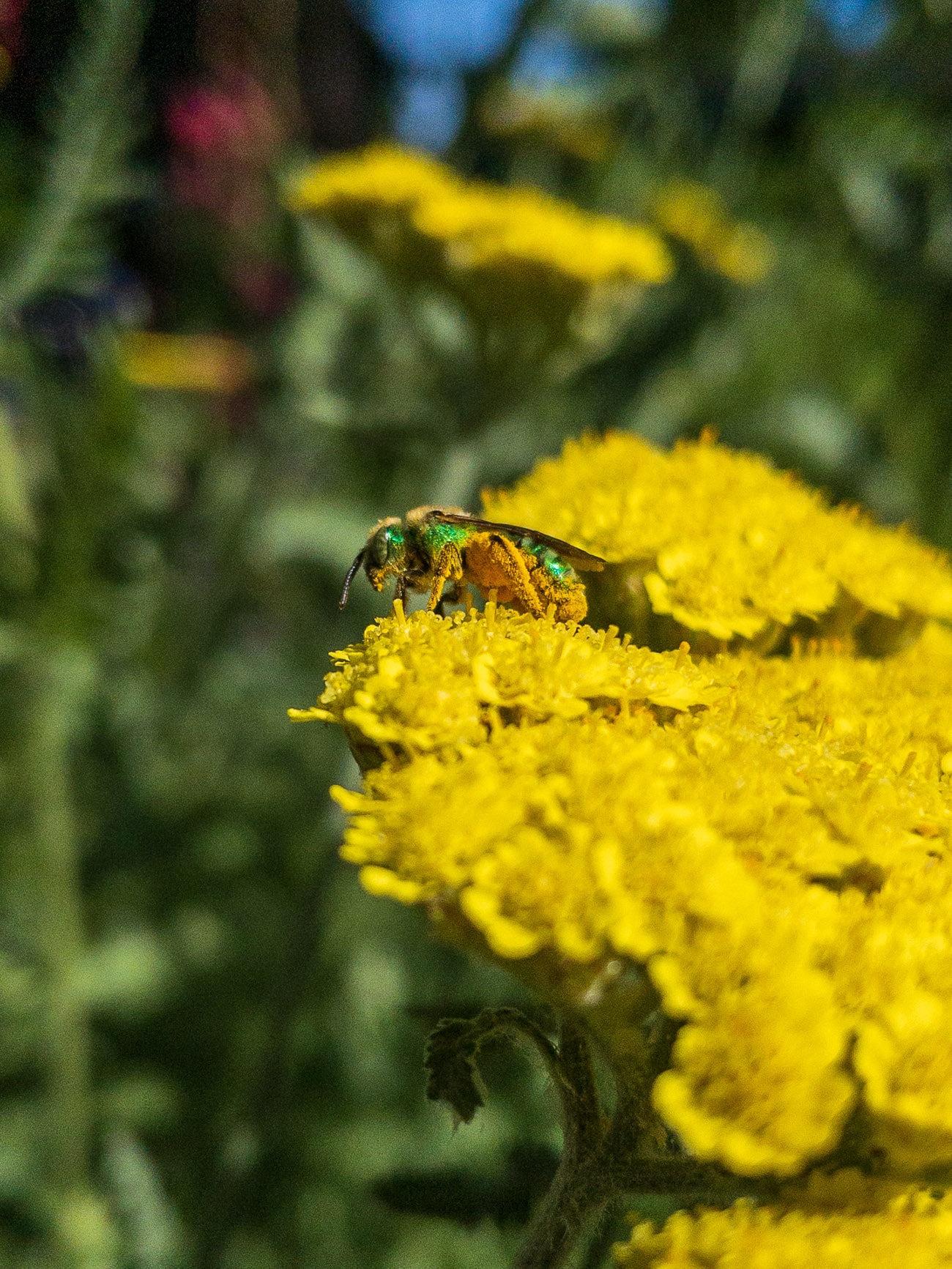
I suspect the stereotype of bees is furthered by bumblebees, which is the second type of bee anyone learns about. They’re more yellow than gold, and not as striped as honeybees but they’re also social nesters. A bumblebee nest, however, is nothing fancy: it can be started in a messy pile of wool in a shed or a vacant mouse nest. They don’t make honey, they just make more bees and queens, who will eventually hibernate in the piles of debris and leaves that I already told you to keep in your yard. (Don’t disturb those piles; I once turned my compost late winter and found a queen.)
The third bee you likely learn about, if you ever get this far, is the mason bee. A common orchard mason bee is bluish-black; it comes out in early spring, will work in rainy weather, and is an excellent pollinator. It gets it name from the way it uses mud, like a mason, to create chambers in a tunnel and seal up its nest. Just to shame the honeybees a bit more, a single mason bee can do the work of about 100 honeybees. That kind of ratio doesn’t seem possible. But it is. And yet there are people who drive large trucks full of honeybees to help pollinate commercial farms and then pack up and drive them to other commercial farms. To recap: Honeybees, likely from Europe, are less efficient than our native bees but they can pollinate throughout the year so we put them on the highway.
And this is why buying and making nesting homes for solitary bees has become a popular thing to do. You can buy mason bee cocoons, set them out when it’s warm, and they’ll crawl out fully-formed and start pollinating the earliest flowers. If you provide empty tunnels or nesting trays, and they have the right kind of mud nearby (this is crucial), they’ll stay in your yard and you can collect the cocoons later in the year. Then you have a recurring supply of efficient pollinators, no bee suits or smokers required.
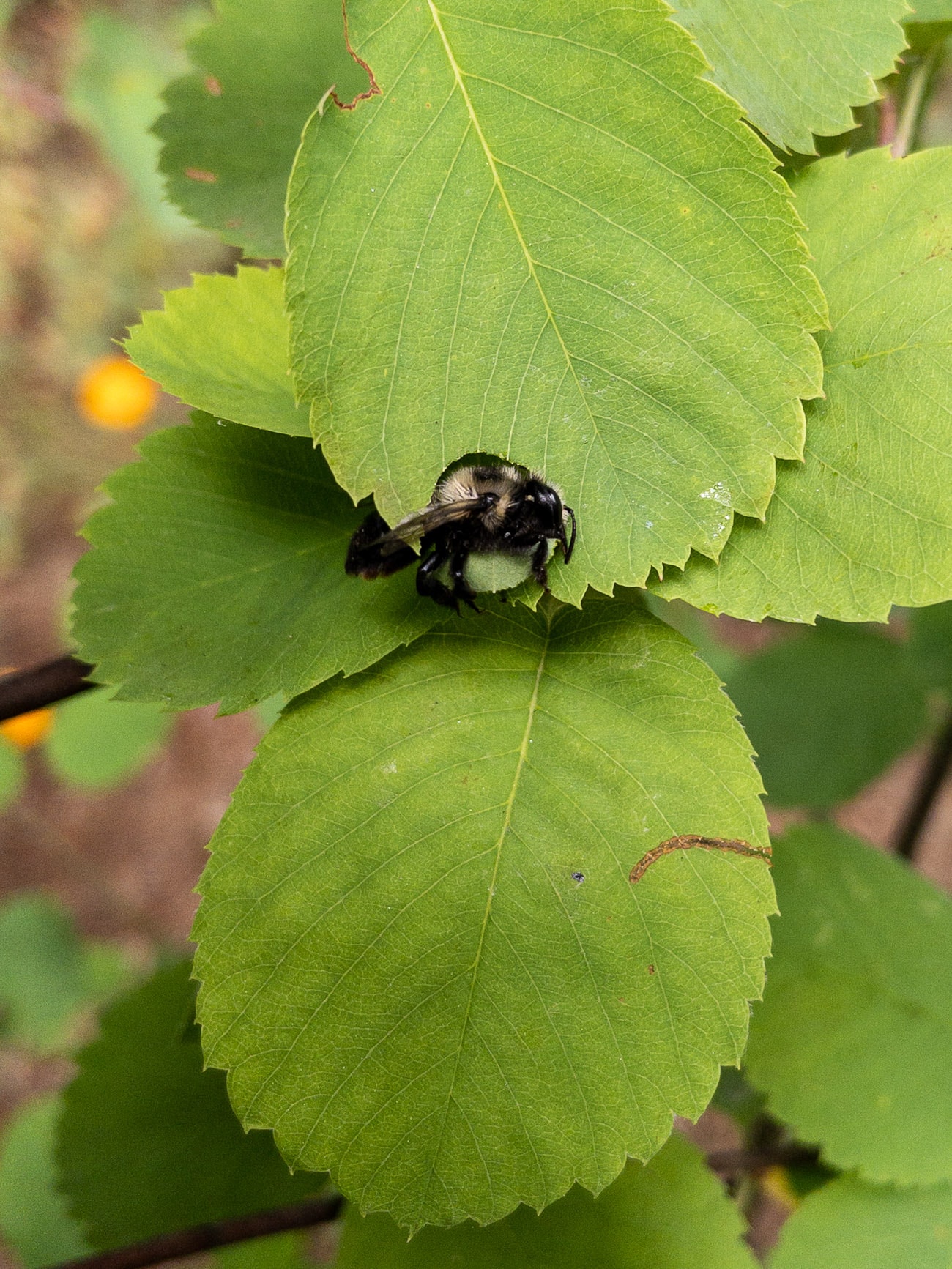
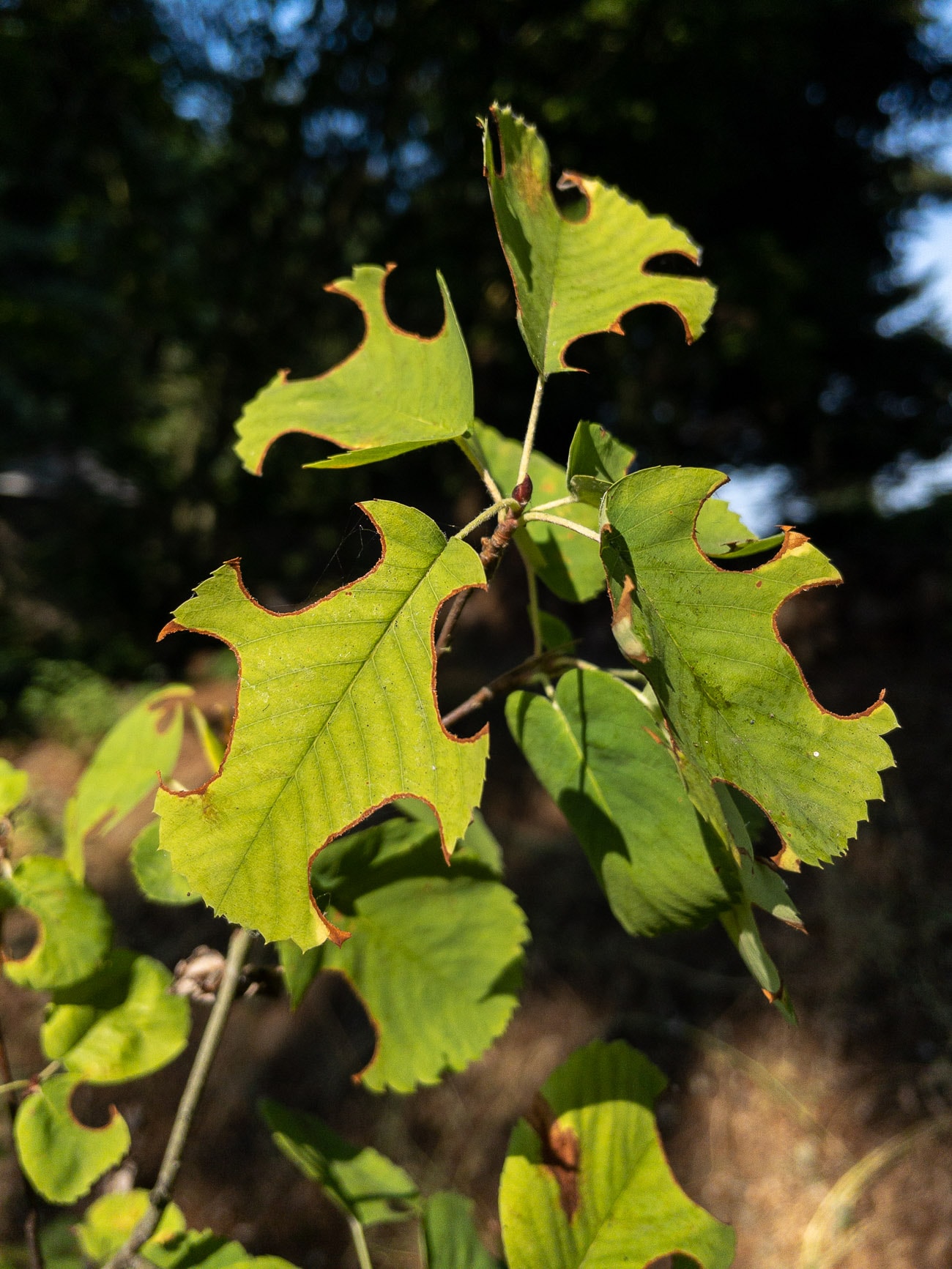
Validation
Each year that I increase wildflowers, especially annuals, I see more native bees in the yard ranging from tiny black ones to shiny green ones that look like robots. They’re quick and harder to photograph than bumblebees, but I’ve seen them dig holes in bare dirt and crawl into gaps of wood. If your idea of a bee was the default1—a honeybee and a hive—you would definitely not notice these wild bees around you.
To gain firsthand experience with solitary bee nests, this month I built a wooden nesting box and bought mason bee nesting trays from Crown Bees, a local company in Woodinville. In a couple weeks I’ll set out cocoons that are currently in my fridge, provide them with clay mud because my soil is too sandy, and see if they like it here. If they do, they’ll be a beneficial pet of sorts, helping my blueberries, apple trees, and native shrubs that fruit. This process will last from about April to June.
But if the assisted nesting is unsuccessful, that’s just fine. Because what I’m most looking forward to this year is the return of the leaf-cutter bee. The best thing that has happened in my yard was the appearance of that native leaf-cutter, last June. Getting close enough to hear it bite through a leaf was like something from a nature documentary. I was elated that the yard was working. It wasn’t about how things looked, it was about how things were being used. And it was all because I provided plants that this bee has evolved with—native species that it understands.
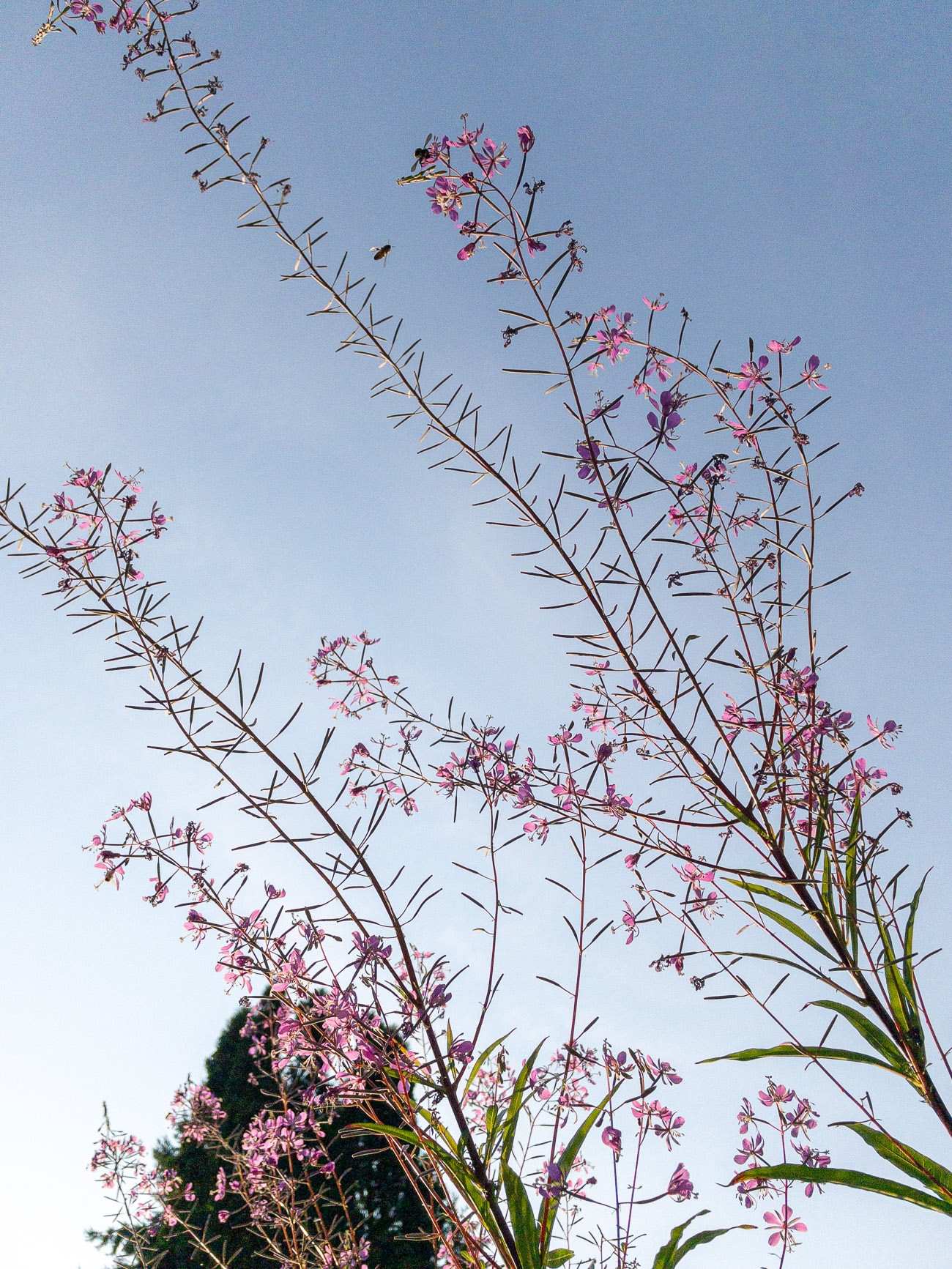
I stopped watering the front yard after my encounter with the leaf-cutter’s nest. It may have been hot and really dry last summer, and some plants may have been suffering, but baby bees were being delivered under foot.
The last time I watched the bee leave her hole in the ground, I tracked her as best I could. I had already spent time in my own yard looking for holes in leaves, but I only ever found them in the serviceberry where I first observed the bee. Other soft leaves of similar size, from non-native plants like lilacs, were plentiful and close by but all left untouched.
I crossed the street to my neighbor’s driveway, where she has a fireweed that showed up a couple years ago. This is one of those plants that pops up in disturbed areas and beside highways. It’s not a garden plant, right? But she liked the pink flowers and I encouraged her to keep it. Now in the summers, the perennial towers eight feet over her driveway and is absolutely covered in bees. It hums.
It didn’t take long for me to find what I was looking for that morning. Not the bee herself, but more evidence that she had what she needed. I reached through the long narrow leaves of the fireweed. She had been here alright.
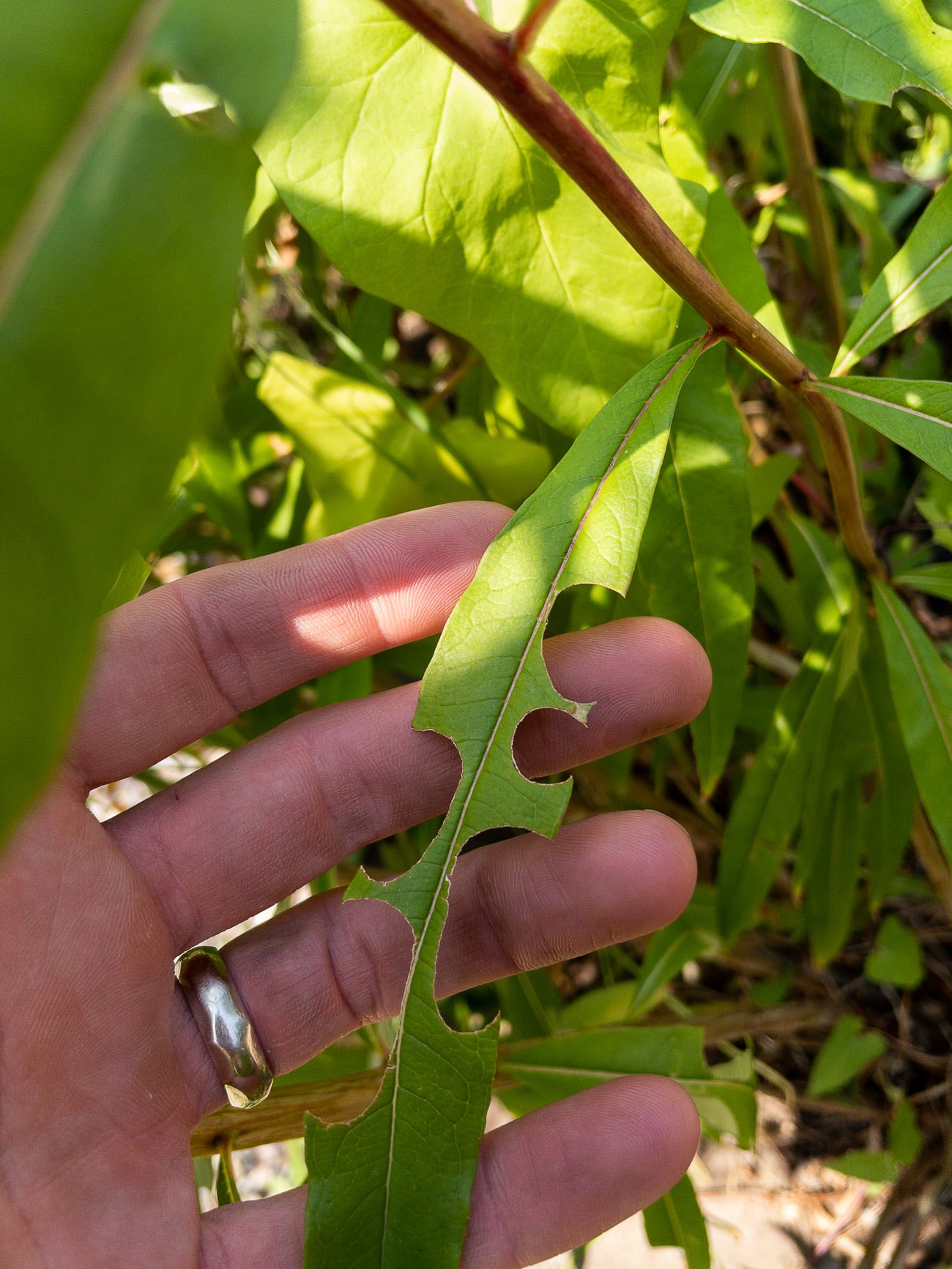
-
Note that even on the EPA webpage about Colony Collapse Disorder, linked to above, the word “bee” is mentioned six times by itself before “honey bee” is used. When people say bee they probably mean honeybee. It’s like if people said “bird” but only ever meant robins. That would seem weird. ↩